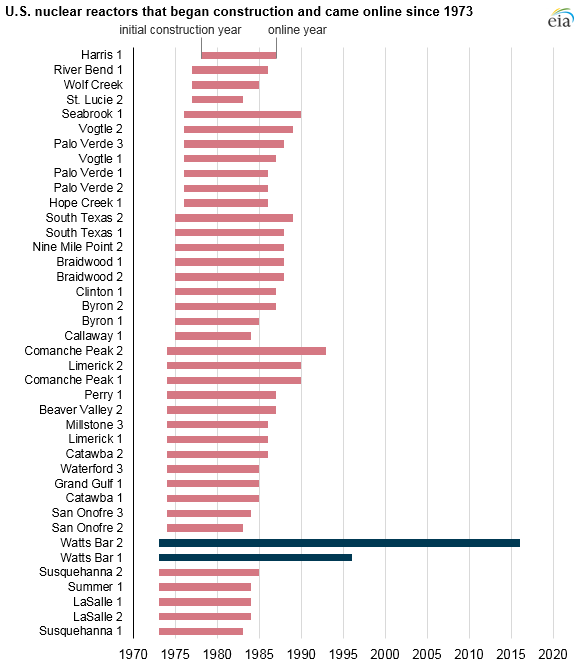43 years after the start of initial construction, the Watts Bar 2 nuclear reactor is set to begin operations
The first United States’ nuclear power plant to come online in two decades was connected to the power grid June 3, making it the first reactor to meet new guidelines set by the U.S. Nuclear Regulatory Commission (NRC) following the Fukushima Daiichi Nuclear Plant accident in 2011.
The Tennessee Valley Authority’s (TVA) Watts Bar Unit 2 is the first nuclear reactor to come online since 1996, when the Watts Bar Unit 1 started operations. The new reactor is designed to add 1,150 megawatts of electricity generating capacity to southeastern Tennessee, according to the EIA.
Construction on Watts Bar Unit 2 originally began in 1973, but construction halted in 1985 after the NRC identified weaknesses in TVA’s nuclear program. In August 2007, the TVA board of directors authorized the completion of Watts Bar Unit 2, and construction started in October 2007.
At the time, a study found Unit 2 to be effectively 60% complete with $1.7 billion invested. The study said the plant could be finished in five years at an additional cost of $2.5 billion. The study proved to be overly optimistic, however, as construction was not finished until 2015, and cost ultimately totaled $4.7 billion.
Ultimately, 23 other nuclear reactors began construction and operations in the 43 years required to finish Watts Bar 2. Four other reactors are currently under construction and are expected to join the nuclear fleet within the next four years. Vogtle Electric Generating Plant Units 3 and 4 in Georgia and Virgil C. Summer Nuclear Generating Station Units 2 and 3 in South Carolina are scheduled to become operational in 2019-2020, adding 4,540 MW of generation capacity.
According to the EIA, as of December 1, 2015, there were 99 operating nuclear reactors at 61 nuclear power plants in the United States. The largest of these is the Palo Verde plant in Arizona, which has three reactors and a combined generating capacity of about 3,937 MW.
Nuclear power plants are considered to deliver carbon-free electricity since they do not emit carbon dioxide.
In 2015, the United States generated about 4 trillion kilowatthours of electricity, according to the EIA. About 20% of the electricity generated was from nuclear power plants.
Major energy sources and percent share of total U.S. electricity generation in 2015:
Coal = 33%
Natural gas = 33%
Nuclear = 20%
Hydropower = 6%
Biomass = 1.6%
Geothermal = 0.4%
Solar = 0.6%
Wind = 4.7%
Petroleum = 1%
Other gases = <1%
(Source: EIA –based on generation by utility-scale facilities)


